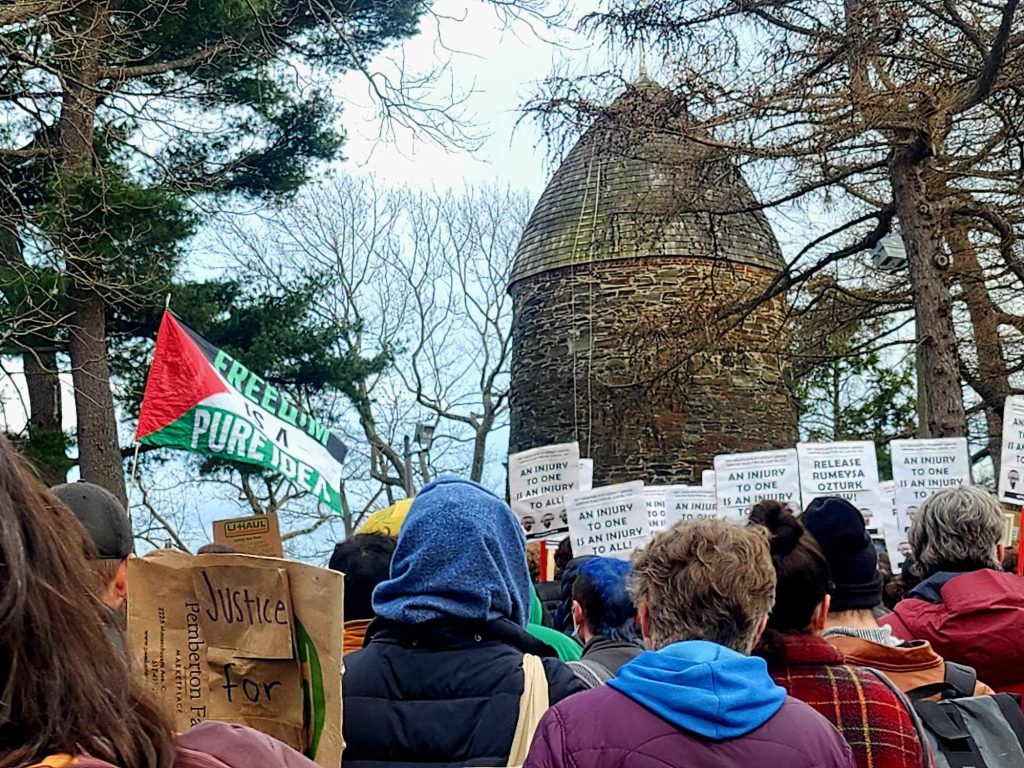[[{“value”:”
by Travis Wayne
The views expressed in this article are the author’s own and do not represent the official position of Working Mass.
On Tuesday night, ICE abducted Rumeysa Ozturk. A Turkish national with a valid F-1 visa, Rumeysa is a Tufts grad worker, student activist, and member of SEIU Local 509. She is also a Somerville tenant. After her doxxing by Canary Mission and monitoring her home in unmarked cars for several days, five ICE agents ambushed Ozturk from all directions wearing plainclothes and masks. Thirteen DSA and YDSA chapters across New England released a statement describing ICE as a “Gestapo” secret police.
ICE kidnapped Ozturk for the crime of authoring an op-ed.
Immediately, the Coalition for Palestinian Liberation at Tufts and the Palestine Youth Movement organized an emergency protest with dozens of other groups – notably unions, like the Tufts Graduate Student Union and Rumeysa Ozturk’s own Local 509. Foot traffic converged across the city as thousands descended upon one site: Powder House Park, the same hill where crowds decided to organize the Minutemen information network that sustained the American Revolution to throw off British rule. Rally organizers were aware of the symbolism. Powder House Square was where one tyrant’s end began; “We are about to do it again,” tour docent Mary Mangan shouted. Boston DSA released a rapid-fire email before 9 AM calling for mobilization to Powder House. In the Somerville DSA branch, we conducted direct outreach to hundreds of active members and supporters to mobilize their relative networks to the square.
The next day, Somerville DSA members showed up at an action organized by Somerville for Palestine in force with a crowd of hundreds shouting freedom slogans surging at police blocking the masses from swarming City Hall for a resolution to divest Somerville from Israeli apartheid.
The mood was as militant as the rally speakers. People called for the abolition of ICE and the release of all political prisoners like Rumeysa Ozturk and Mahmoud Khalil. Benny from the ICE Somerville Watch Network shouted “the Democratic Party will not save you! They did not save Rumeysa!” to thunderous applause. One organizer made the audience shout the local ICE watch hotline back. Speakers drummed people to turn out to City Hall to support Somerville for Palestine’s measure to end Somerville investments in apartheid companies the next day, where the council ultimately voted 9-2 to make the task as hard as possible for Palestinian organizers.
Only DSA cadre elected officials Willie Burnley Jr. and JT Scott voted for Palestine in Somerville’s ruling chamber.
Was further escalation possible?
The rally dispersed rather than escalated. Henry De Groot, managing editor of this paper, pointed out that the “rally could have marched to Tufts and launched an occupation until [Rumeysa] is free” and that we “need militant tactics to match our militant mood.” Tech worker Eve Seitchik argued the rally was a “missed opportunity to channel the anger into pressure.”
They’re right. Occupation when media helicopters were already on scene would have fixed national attention on Somerville beyond one news cycle, maintaining attention on the demands of organizers to release Rumeysa Ozturk. That would have created immense pressure on Tufts University, which would face a crisis point as millions of dollars were lost in donations to follow Columbia’s lead in becoming a handmaiden of fascism or fighting against Trump on behalf of Somerville tenants abducted by the secret police. Occupation conceivably could have applied far more pressure on the Somerville City Council to divest from Israel, in the short run, and greater pressure on Tufts to divest and reinstate the Students for Justice in Palestine (SJP) chapter that Tufts suspended for raising funds for Gaza in the long run. The strategic choice made Rumeysa’s abduction a flashpoint but not necessarily a climax. Further escalation is harder when you have to re-mobilize the masses and then re-stoke their anger.
None of this is a mistake by students responding quickly and effectively to new strategic conditions. Instead, these are an illustration of those conditions students now face. One year ago, student organizers especially associated with Students for Justice in Palestine (SJP) organized mass encampments not seen since SDS’s occupations in the Sixties. Those drew immense national attention, forced Palestine into mainstream discourse, and applied pressure directly on entities both deeply invested in Israeli apartheid and often the largest landlords in their communities: the universities. Now, Columbia University – the site of the second such occupation after Vanderbilt – cowers in fear at the feet of Trump. Desperate to keep $500 million in grants, Columbia willingly assists the new regime in deporting their own students while Tufts suspends its students on the grounds of “gambling” for raising funds to stop a genocide.
The culture of fear that abduction creates, abetted by the complicit universities, acts as a significant disincentive to occupation for student organizers on the frontline. Students historically have the unique capability of organizing high-risk spatial occupations of their own campuses. The broader working class does not occupy the quad alone. Outside organizations only have the leverage to materially assist occupations of university property but lack the political capital to initiate them. Now, however, the regime is curbing the rights students have that enable occupation through the high-profile targeting of Mahmoud Khalil and Rumeysa Ozturk. Fewer people with green cards and even fewer people without papers will take risks that draw attention to the genocide by the Zionist state occupying Palestine. The Trump Administration is actively targeting the Palestine movement, both student and non-student, by blunting an important strategic weapon in our arsenal: campus occupation.
Students will continue to escalate in new arenas for Palestine, but they lead our movement forward despite the higher risks that the new regime has intentionally raised to attack the student wing of the working class.
Class organization and collective risk
Students losing their rights does not make occupation impossible – class disorganization does. The Young Lords occupied Lincoln Hospital, forming relationships with healthcare workers, barricading themselves inside the grounds of their “people’s hospital” to raise attention for healthcare access and conditions in their South Bronx community. The Lords were an effective organization of their immediate working class Puerto Rican community and the Lords’ demands received decades of attention beyond the twelve hours of occupation. Their cadre had capacity to undertake collective risk. We lack that same capacity now. That’s partly because DSA is organized as a mass organization and not a cadre organization like the Young Lords. Generally, that’s to our strength, interconnecting us more deeply with social worlds beyond the organization, but structure isn’t the only reason. Collective risk requires solidaristic trust that’s impossible when organizers act like sectarians instead of comrades.
But DSA’s lack of capacity to take collective risk at the strategic moment occurs at the same time that labor itself remains too weak to take that same level of collective risk. Straightforward solidarity strikes are banned, but more importantly, most people mobilized to Powder House Park were not union members. They weren’t deeply organized nor connected beyond word-of-mouth and group chat. Unions that did mobilize their memberships don’t have a shared movement-wide communications democracy capable of leveraging militant memberships to escalate in coordination with one another. In other words, we need to organize ourselves into unions and organize our unions, not only to contract but with depth, to become militant enough to form the rapid response capabilities we need to protect our communities.
Labor unions can knit together the working class into networks of solidarity capable of mass mobilization, but tenant unions form an essential supplementary bedrock. ICE is abducting people from their workplaces but also their homes. Rumeysa Ozturk was almost home to break her Ramadan fast. Tenant unions, which form class organization at the neighborhood level, connect neighbors and make the solidaristic bedrock of public safety. Neighbors who know each other’s children, who knock doors with each other, who break bread with each other form the bonds of community defense, “[making] the community by defending it.” The fact that tenant unions are on the rise, including the local Greater Boston Tenants Union, but have not reached the level of density across the tenant class needed to defend against ICE onslaught is tragic. We need to organize tenant unions to create the layer of community defense at the neighborhood level capable of protecting tenants like Rumeysa Ozturk. Tenants, organized together, can block evictions by both landlords and secret police.
The only way we defend ourselves as entire communities against ICE is greater class organization. That’s necessary from the workplace to the home to the academy. Unions, along with a coalition of community organizations, were the ones that mobilized the incredible mass mobilization for Rumeysa Ozturk. Unions of both workers and tenants need to deliver know your rights to as many people as possible, but also practical information on raising the alarm as bystanders during ICE abductions and reporting undercover ICE vehicles like Union del Barrio does in South Los Angeles: as organizers there note, ICE patrols in Chevy Impalas, Dodge Durangos, and Ford Explorers. And even as we build the organization needed to take greater collective risks, we need to train each other and as many people as possible to support hotlines for reporting ICE incidents like LUCE in Somerville. Finally, we need to support one another and defend each other – especially student tenants, deeply vulnerable, who have already begun organizing a walk-out under Medford Coalition for Palestinian Liberation as further escalation in their intifada.
Make no mistake; we are all under attack.
Travis Wayne is an organizer with the Greater Boston Tenants Union and co-chair of the Somerville branch of Boston DSA. They serve as deputy managing editor of Working Mass.
“}]]

